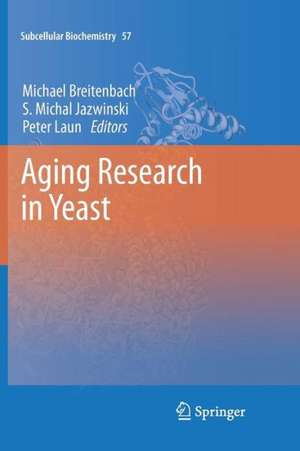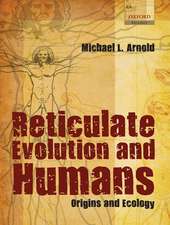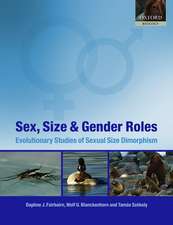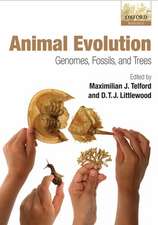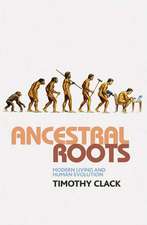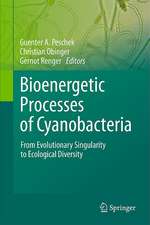Aging Research in Yeast: Subcellular Biochemistry, cartea 57
Editat de Michael Breitenbach, S. Michal Jazwinski, Peter Launen Limba Engleză Paperback – 28 ian 2014
| Toate formatele și edițiile | Preț | Express |
|---|---|---|
| Paperback (1) | 943.08 lei 43-57 zile | |
| SPRINGER NETHERLANDS – 28 ian 2014 | 943.08 lei 43-57 zile | |
| Hardback (1) | 954.62 lei 43-57 zile | |
| SPRINGER NETHERLANDS – 19 noi 2011 | 954.62 lei 43-57 zile |
Din seria Subcellular Biochemistry
- 18%
 Preț: 948.79 lei
Preț: 948.79 lei - 5%
 Preț: 1456.88 lei
Preț: 1456.88 lei - 18%
 Preț: 1373.84 lei
Preț: 1373.84 lei - 18%
 Preț: 1243.78 lei
Preț: 1243.78 lei - 18%
 Preț: 2098.81 lei
Preț: 2098.81 lei - 18%
 Preț: 1122.10 lei
Preț: 1122.10 lei - 5%
 Preț: 1160.63 lei
Preț: 1160.63 lei - 18%
 Preț: 1396.26 lei
Preț: 1396.26 lei - 18%
 Preț: 1114.96 lei
Preț: 1114.96 lei - 18%
 Preț: 1224.68 lei
Preț: 1224.68 lei - 18%
 Preț: 951.29 lei
Preț: 951.29 lei - 18%
 Preț: 1227.99 lei
Preț: 1227.99 lei -
 Preț: 398.15 lei
Preț: 398.15 lei -
 Preț: 399.88 lei
Preț: 399.88 lei - 18%
 Preț: 1231.47 lei
Preț: 1231.47 lei - 18%
 Preț: 1230.35 lei
Preț: 1230.35 lei -
 Preț: 392.60 lei
Preț: 392.60 lei - 18%
 Preț: 1231.47 lei
Preț: 1231.47 lei - 15%
 Preț: 638.76 lei
Preț: 638.76 lei - 5%
 Preț: 656.26 lei
Preț: 656.26 lei -
 Preț: 389.49 lei
Preț: 389.49 lei - 5%
 Preț: 659.19 lei
Preț: 659.19 lei -
 Preț: 392.37 lei
Preț: 392.37 lei - 5%
 Preț: 662.09 lei
Preț: 662.09 lei -
 Preț: 395.09 lei
Preț: 395.09 lei - 5%
 Preț: 667.99 lei
Preț: 667.99 lei -
 Preț: 400.47 lei
Preț: 400.47 lei - 18%
 Preț: 1224.54 lei
Preț: 1224.54 lei - 15%
 Preț: 647.73 lei
Preț: 647.73 lei - 15%
 Preț: 646.75 lei
Preț: 646.75 lei - 5%
 Preț: 662.30 lei
Preț: 662.30 lei -
 Preț: 395.25 lei
Preț: 395.25 lei - 18%
 Preț: 1230.21 lei
Preț: 1230.21 lei - 18%
 Preț: 1231.95 lei
Preț: 1231.95 lei - 18%
 Preț: 964.54 lei
Preț: 964.54 lei
Preț: 943.08 lei
Preț vechi: 1150.10 lei
-18% Nou
Puncte Express: 1415
Preț estimativ în valută:
180.46€ • 188.89$ • 150.20£
180.46€ • 188.89$ • 150.20£
Carte tipărită la comandă
Livrare economică 31 martie-14 aprilie
Preluare comenzi: 021 569.72.76
Specificații
ISBN-13: 9789400794207
ISBN-10: 9400794207
Pagini: 380
Ilustrații: XII, 368 p.
Dimensiuni: 155 x 235 x 20 mm
Greutate: 0.53 kg
Ediția:2012
Editura: SPRINGER NETHERLANDS
Colecția Springer
Seria Subcellular Biochemistry
Locul publicării:Dordrecht, Netherlands
ISBN-10: 9400794207
Pagini: 380
Ilustrații: XII, 368 p.
Dimensiuni: 155 x 235 x 20 mm
Greutate: 0.53 kg
Ediția:2012
Editura: SPRINGER NETHERLANDS
Colecția Springer
Seria Subcellular Biochemistry
Locul publicării:Dordrecht, Netherlands
Public țintă
ResearchCuprins
1. Preface and Introduction to Aging research in Yeast.- 2.Oxidative stresses and ageing.- 3.The role of Mitochondria in the aging processes of yeast.- 4.The Retrograde Response and Other Pathways of Interorganelle Communication in Yeast Replicative Aging.- 5. Chronological Aging in Saccharomyces cerevisiae.- 6. Still waters run deep: Aging and the survival of quiescent and non-quiescent cells in yeast stationary-phase cultures.- 7. Maximising the yeast chronological lifespan.- 8.Amino Acid Homeostasis and Chronological Longevity in Saccharomyces cerevisiae.- 9. DNA damage and DNA replication stress in yeast models of aging.- 10.Yeast aging and apoptosis.-11. Cellular homeostasis in fungi: Impact on the aging process.- 12.Genome-wide analysis of yeast aging.- 13. Genetic Approaches to Aging in Budding and Fission Yeasts: New Connections and New Opportunities.- 14. Evolution of asymmetric damage segregation: a modelling approach.-15. Cellular ageing and the actin cytoskeleton.
Recenzii
From the reviews:
“This book compiles some of the most exciting and promising research to date in the fields of anti-aging, longevity, and possibly even rejuvenation. The authors’ research examines the role of senescence in yeast and how it may relate to the chaotic autophagy of cancer cells. In sum, Aging Research will stir interest in both scientific and non-scientific arenas.” (The Electric Review, October, 2012)
“This book compiles some of the most exciting and promising research to date in the fields of anti-aging, longevity, and possibly even rejuvenation. The authors’ research examines the role of senescence in yeast and how it may relate to the chaotic autophagy of cancer cells. In sum, Aging Research will stir interest in both scientific and non-scientific arenas.” (The Electric Review, October, 2012)
Textul de pe ultima copertă
This volume includes contributions by the leading experts in the field of yeast aging. Budding yeast (Saccharomyces cerevisiae) and other fungal organisms provide models for aging research that are relevant to organismic aging and to the aging processes occurring in the human body. Replicative aging, in which only the mother cell ages while the daughter cell resets the clock to zero is a model for the aging of stem cell populations in humans, while chronological aging (measured by survival in stationary phase) is a model for the aging processes in postmitotic cells (for instance, neurons of the brain). Most mechanisms of aging are studied in yeast. Among them, this book discusses: mitochondrial theories of aging, emphasizing oxidative stress and retrograde responses; the role of autophagy and mitophagy; the relationship of apoptosis to aging processes; the role of asymmetric segregation of damage in replicative aging; the role of replication stress; and the role of the cytoskeleton in aging. Modern methods of yeast genetics and genomics are described that can be used to search for aging-specific functions in a genome-wide unbiased fashion. The similarities in the pathology of senescence (studied in yeast) and of cancer cells, including genome instability, are examined.
Caracteristici
Yeast aging research and its relevance to humans Thorough account of a rapidly expanding field Offers a molecular cell biology perspective on aging Written by authorities in the field of aging research
